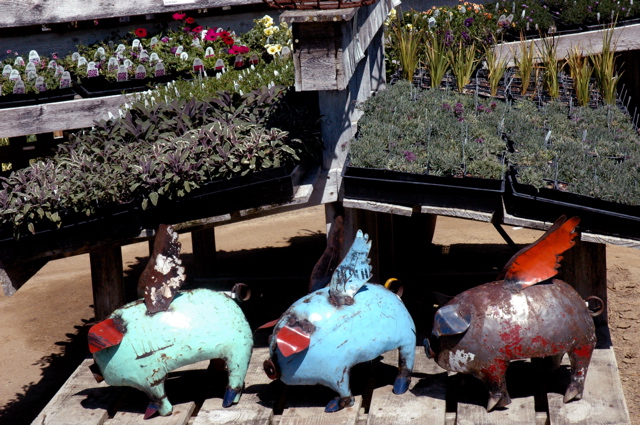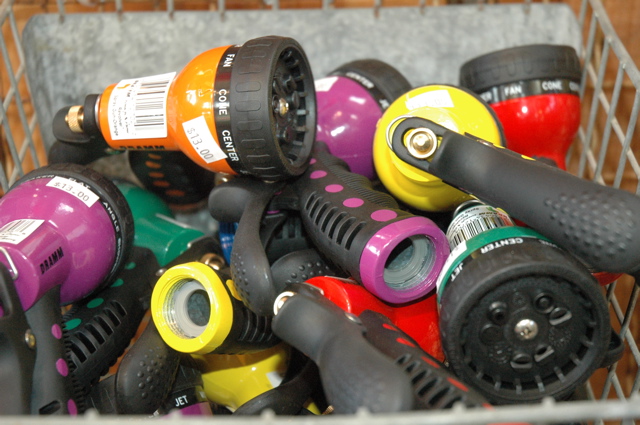
This summer, with a plethora of states across the country experiencing drought conditions, learning about low-volume watering is crucial to having your yard survive the dry months. This simply means applying water to a uniform depth directly to the plant's root zone. This reduces water waste and your water bill at the same time. It's win-win. But first, let's make sure you're soil is helping you by holding all the moisture it can.
What's Up with your Soil?
Before changing anything having to do with your irrigation system, add 2-3 inches of compost (either homegrown or purchased at the plant nursery or Waste Management site) on top of your soil. Do this once or twice a year preferably in the fall and spring. You don't even have to dig it in. Digging is so old school! The microorganisms in the compost will nourish your soil doing the underground work for you. Incorporating compost (organic matter) increases the water-holding capacity of your soil. With sandy soil, you'll lose less water to the subsoil and with compacted clay soil, water will easily and slowly trickle its way to the plant's roots, instead of sitting on the top floor, uselessly, like a lump on a log.
Once you've placed compost around your plants, it's also a fantastic idea to add a 2-3 inch layer of mulch. Some mulch options are wood chips, shredded bark, grass clippings, stems and leaves, straw or cocoa hulls. Many recycling centers now give away compost and/ or mulch to the community for free instead of adding it to overcrowded landfills. Check in your town. You can also contact a local arborist and ask them for wood chips. Spread the mulch around the plants but try to keep it a few inches away from the main stem or tree trunk to avoid pests and fungal problems.
Are You the One Watering the Sidewalk?
If you're budget allows, get rid of all those sprinklers! A sprinkler system has only one place in the landscape and that's on the lawn. Every other part of your yard should be watered with a drip system or by a soaker hose. Sprinklers lose a large amount of water to evaporation in the air. Plants are in the ground. Your plants aren't in midair, are they? (If they are, send me a photo. That is so cool!)

The queen bee of irrigation is the drip system. Drip emitters place water directly to the plant's roots. Studies have shown that a well-designed drip system uses at least 30 percent and in some cases, 50 percent, less water than other irrigation methods. A drip system isn't complicated to install, especially if you liked playing with Tinker Toys as a kid but it can be time-consuming if you're a novice. It can be a fun weekend project until you realize that the one attachment valve you're missing is halting the whole wicked endeavor. Then it's back to the garden center to search for a piece of plastic barely an inch long. (The patient guys who work or shop in the plumbing department, at my local Ace Hardware Store, have witnessed me in near meltdown stage, muttering expletives to myself and have come to my rescue many times. Thank you plumbers all around the world! )
Once you've set up your drip system you may want to add a timer to it. There are straightforward ones you can set up yourself or if you have a large yard with many different drip lines, it would behoove you to hire a home landscape irrigation specialist.
A soaker hose is simpler, less expensive and less time consuming. It's a hose you'll lay on the ground with pin-size holes in it. A soaker hose costs about thirty dollars and comes in lengths from 25 to 50 feet long and works well on flat surfaces. They're quicker and easier to install and maintain but they don't save as much water as drip irrigation.
Large Lawns are Like Leg-Warmers
They're both so 1980's! Lawns are a nice idea if you live in New England or Minnesota and have those magical summer rainstorms but if you're in droughty California, start removing part of your lawn slowly and replacing thirsty, needy turf with groundcovers or a native wildflower mix.
67 million pounds of pesticides are applied to roughly 30 million acres of lawns in the U.S. each year and homeowners are using 40-60 percent of their summer water allotment on their lawn. Lawn grass is the #1 most water intensive crop in the US. The average lawn is doused with 10,000 gallons (not rainfall) of water each year.
Say goodbye to your front lawn or part of it come this fall and just END IT! The fall is a good time to remove the lawn physically or sheet mulch it with newspapers or cardboard. To learn how to sheet mulch, see www.stopwaste.org Or, better yet, buy my book about organic gardening, called TALKING DIRT (Penguin, 2010). How's that for shameless self-promotion!?
If you're dead set on staying in that codependent, sad relationship with your lawn, at least learn how to take care of it organically so you're not poisoning the entire zip code with lawn chemicals that have been linked to cancer, birth defects, autism and Parkinson's disease. See www.safelawns.org for tips on that or pick up a copy of Paul Tukey's Organic Lawn Care Manual.
Helpful Tips for Conserving Water
If you're thinking of planting a new tree in your garden, consider planting a deciduous tree on a south-facing wall. This way, in the summer, the leaves will shade your garden and house. In the winter, the bare branches will allow the warmth of the sun into your home and yard.
Water the lawn before sunrise when water isn't evaporating. Fertilize the lawn organically. Synthetic fertilizers have a high salt content which makes plants even thirstier. Just like humans, plants and turf do better on a low-salt diet! If possible, break up your lawn watering into 2 intervals, with time in between for absorption, to prevent runoff.
Trees require deep watering instead of many shallow ones. Lay a hose at the drip line of the tree every 2 weeks or so in the hot summer, and let it soak down to a good depth for roughly 20 minutes. It's a good idea to set an alarm clock so you don't forget to turn the water off (and blame me).
If you're thinking of removing a section of lawn and replacing it with low-maintenance plants, some easy perennials that spread far and wide are yarrow, chamomile, erigeron, festuca, gaura, Stachys and creeping thyme.
Many Master Gardeners recommend using hydro-mats or Terra-Sorb's drought-proof crystals in potted plants to absorb the water and release it slowly to the plant. Both are not damaging to the soil and are a good solution when you're away on vacation. Available at most garden nurseries or online at www.Gardeners.com
Check your sprinkler, hoses and drip system emitters periodically throughout the summer for leaks. This will save you money and guilt.

